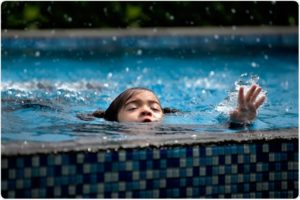Swimming safety rules for children – Follow swimming safety rules strictly, whether swimming in pools, at home, in the ocean, open water or in the lake. Swimming is lot of fun and a very good exercise too. Yet it must be remembered that accidents during swimming are common and often fatal.
Swimming safety rules for children explained !
Children between the ages of one and three are the primary victims of drowning in swimming pools at home.
Some parents put their wards through early swimming training and think that the child can then be left alone in a pool without fear of drowning.
But, it must be remembered that while drowning young children seldom splash or cry for help loud enough to alert people nearby.
Other important swimming safety rules for children swimming in a pool or open water
Never ever leave a child unsupervised near a pool. Do not let fences and barriers around a pool give a false sense of security. Children usually find a way to get around them.
Do not rely on the floatation device being used by a child as completely safe. Always keep the child in sight when he is in the pool. Beginners should also be under constant supervision.
Children under three should not be trained in a group, but on a one-to-one basis by a trained swimming instructor.
Drowning accidents can occur during a group training of small children because several children may need attention at the same time which cannot be provided by one instructor.
Do not keep toys near the pool. A child playing with them could fall into the pool. This is especially true with tricycles, balls, etc.
No one should push playmates, jump on another person, or do any other kind of potentially dangerous activity in the pool.
In any social gathering around a pool, someone should keep a vigilant eye on the pool, especially if children are present or if people are drinking alcohol.
There is a myth that a drowning person comes up thrice before he finally goes down. This is simply not true.
Barriers
Effective barriers against unauthorized entry into the pool should be erected.
All doors and windows to the pool should be the self-closing and self-latching type. The latches should be at such a height that these cannot be reached by a youngster who wishes to enter the pool area.
A float line should be stretched across the pool to indicate where the deep part begins. This will forewarn all swimmers.
Swimming safety rules for children – How to ensure safe diving :
No one should dive into a shallow pool. First, determine the depth of the pool or river bed and ensure that there are no submerged objects such as rocks, stones, or trees. Before diving, ensure that there are no other swimmers or divers in the area.
Anyone who has taken alcohol or drugs that produce drowsiness should not be allowed to swim or dive. Diving involves keeping an eye for obstacles, judging distances and depths, as well as monitoring speed and directions so as not to collide with any one or anything. For these functions, mental and physical alertness is necessary.
Anyone with a history of epilepsy or heart attack should get his doctor’s permission before attempting to swim. Such a person should never swim alone. Never dive in an above-ground swimming pool. These are rather shallow. A dive in them might result in a grievous injury.
Physicians do not advise swimming immediately after a meal. It is bad for the digestive system. It is wise not to go for a swim during a thunderstorm.
One may be momentarily blinded by lightning and may collide with someone or hit a wall. In rivers, storms may result in a sudden surge of water which can prove dangerous.
Swimming safety rules for children swimming in the ocean
In a river, one should swim at a distance from the bank since a river is generally shallow at the banks and may have submerged steps for bathers or rocks hidden from view.
Keep a distance from boats of all types. Do not hold on to them. The boat can turn upside down. Similarly, keep away from any floating object and be careful about water creatures.
Do not exhaust yourself. It is possible to wander quite far off from the ocean or river bank in your initial enthusiasm.
You may then lack the stamina to return to the bank. Make sure you have enough energy left to return, taking into account the flow of the current in the stream.
Your shouts for help may not be heard on the river bank and hence, help may not reach you in time.
Do not swim alone in an ocean. Swim with a friend so that you both can keep a watch on each other. Alternatively, someone on the bank should keep a constant watch and arrange for rescue in case of an emergency.
Do not swim anywhere near a bridge or dam gates regulating the river flow. There are lots of circular currents or whirlpools which can entangle even a good swimmer.
Do not swim in case of floods, heavy rains, thunderstorms, high waves, strong winds, chilly weather, or too many boats in the river, etc.
These precautions will help make swimming safer and more pleasant for kids and adults.
RELATED TOPICS
How to take care of your teeth and gums
Best hospitals in North Carolina
Top 10 medical tourism destinations

